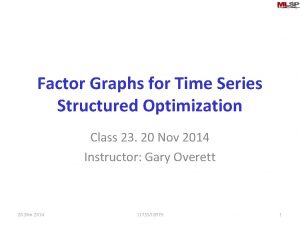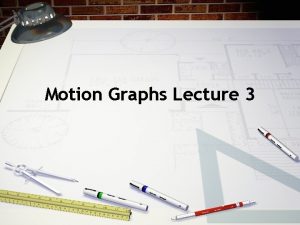Lecture 13 Graphs Introduction to Graphs l Examples








- Slides: 8

Lecture 13 Graphs

Introduction to Graphs l Examples of Graphs – Airline Route Map l l – What is the fastest way to get from Pittsburgh to St Louis? What is the cheapest way to get from Pittsburgh to St Louis? Electric Circuits l l Circuit elements - transistors, resistors, capacitors is everything connected together? – Depends on interconnections (wires) l If this circuit is built will it work? – Depends on wires and objects they connect. – Job Scheduling l l l Interconnections indicate which jobs to be performed before others When should each task be performed All these questions can be answered using a mathematical object named a “graph” – – what are graphs? what are their basic properties?

Introduction to Graphs l l l Graph – A set of vertices(nodes) V = {v 1, v 2, …. , vn} – A set of edges(arcs) that connects the vertices E={e 1, e 2, …, em} – Each edge ei is a pair (v, w) where v, w in V – |V| = number of vertices (cardinality) – |E| = number of edges Graphs can be – directed (order (v, w) matters) – Undirected (order of (v, w) doesn’t matter) Edges can be – weighted (cost associated with the edge) – eg: Neural Network, airline route map(vanguard airlines)

Paths and Graphs – – – A path is a sequence of edges from one node to another A length of a path is the number of edges l If w 1, w 2, …, wn is a sequence of vertices such that (wi, wi+1) in E, then there is a path of length n-1 from w 1 to wn. l what are paths of length 2 in vanguard airlines map? A simple path is a path where no vertex is repeated l first and last vertices can be the same l what is an example of a simple path in the vanguard map? l What is an example of a non-simple path? A cycle (in a directed graph) is a path that begins and ends in the same vertex. i. e. S = {w 1, w 2, …, wn} is a sequence such that w 1 = wn and |S| >1 A directed acyclic graph (DAG) is a directed graph having no cycles.

More Graph Definitions l Connected Graph – – – l Complete Graph – l A graph with all nodes connected to each other directly Maximal Edge count – – l A undirected graph is connected if for all (u, v) in V, there exists a path from u to v. A directed graph is strongly connected if for all (u, v) in V, there exists a path from u to v. A directed graph is weakly connected if for all (u, v) in V, either (u, v) is in E or (v, u) is in E. undirected graph |E|max = (n-1) + (n-2) + … + 2 + 1 = n(n 1)/2 directed graph |E|max = n(n-1) Degree – – number of edges incident to a vertex in a directed graph l l in-degree(sink) - number of edges into vertex out-degree(source) - number of edges from vertex

Some Cardinality Relations l l For most graphs |E| |V|2 A dense graph when most edges are present – – l E = (|V|2) A dense graph large number of edges (quadratic) Also |E| > |V| log |V| can be considered dense A sparse graph is a graph with relatively few edges – – – no clear definition metric for sparsity |E| < |V| log |V| eg: ring computer network

More About Graphs l A graph with no cycles is called a tree. This is a general definition of a tree A G C F l l G B B D C E D E F A group of disconnected trees is called a “forest” A spanning tree of a graph is a subgraph that contains all vertices but only enough of the edges to form a tree. Any additional edge to a tree will form a cycle A tree with V vertices has exactly V-1 edges (induction proof)

Graph Algorithms l Graphs depend on two parameters – – l edges (E) Vertices (V) Graph algorithms can be complicated to analyze – One algorithm might be order (V 2) l – Another might be order((E+V)log E) l l for dense graphs for sparse graphs Depth First Search – – – Is the graph connected? If not what are their connected components? Does the graph have a cycle? How do we examine (visit) every node and every edge systematically? First select a vertex, set all vertices connected to that vertex to nonzero Find a vertex that has not been visited and repeat the step above Repeat above until all zero vertices are examined.
 01:640:244 lecture notes - lecture 15: plat, idah, farad
01:640:244 lecture notes - lecture 15: plat, idah, farad Transition bugs in software testing
Transition bugs in software testing Graphs that compare distance and time are called
Graphs that compare distance and time are called Graphs that enlighten and graphs that deceive
Graphs that enlighten and graphs that deceive Polynomial end behavior chart
Polynomial end behavior chart Introduction to biochemistry lecture notes
Introduction to biochemistry lecture notes Introduction to psychology lecture
Introduction to psychology lecture Introduction to algorithms lecture notes
Introduction to algorithms lecture notes Markov factorization
Markov factorization















